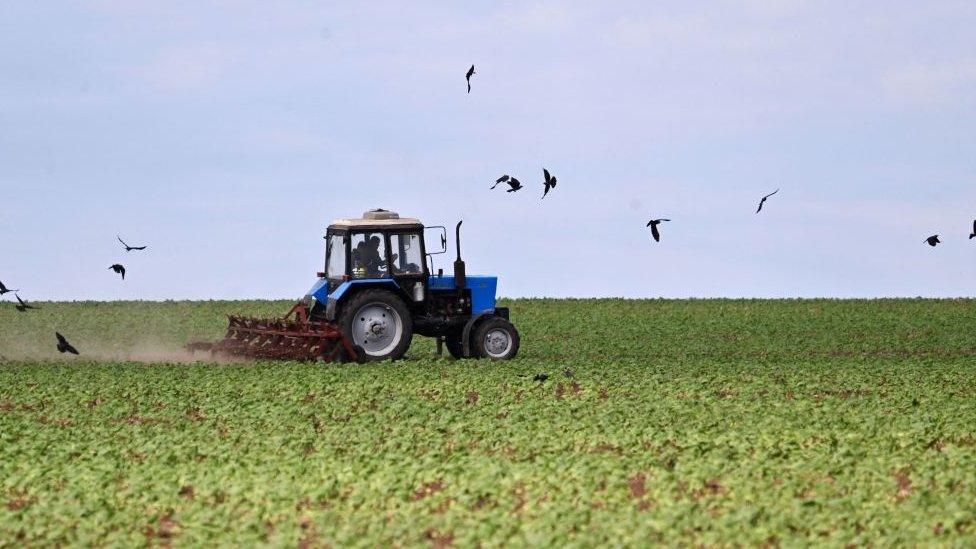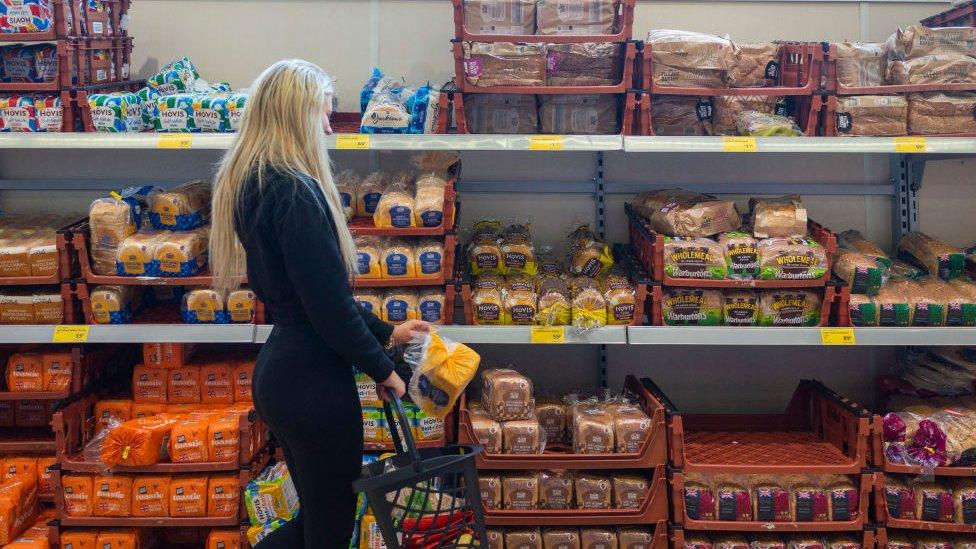War's harvest: the looming food crisis
- Published

Fuel costs hurt, but there are ways oil supply can be boosted to help meet demand.
That is not looking as likely for food, where the crisis is building more slowly. A new UN report points to the risk of it being protracted.
Prices would normally encourage farmers to plant and produce more, but their input prices are also soaring, and future harvests could suffer as a result.
With central heating turned off for a few months, the 'driving season' has focused attention away from gas prices to Britain's transport fuel costs.
The trend line on crude oil remains on a strong upward tilt, while the value of sterling against the US dollar pushes prices of petrol and diesel further up to daily record-breaking prices.
Where will it peak? We don't know. But as a general rule, high prices help stimulate more supply. Oil exporters are trying to raise output (with limited success) to make up for Russia's exclusion from some of its export markets.
And the high-pressure pumps have surged back to work deep under the scrublands of west Texas and New Mexico: America's fracking frontier helps balance energy markets, with short-cycle boom and bust as the price fluctuates.
Higher bills, less food
The same cannot be assured for food. Internationally traded grains, cooking oils and fertilizers have seen prices surge in the past year, and particularly since two of the biggest exporters - Russia and Ukraine - went to war.
A report just published by the United Nation's Food and Agriculture Organisation (FAO), sets out alarming prospects that indicate higher prices will not lead to more supply. Those higher prices may continue rising next year and beyond.
The report is a six-monthly outlook for the world's food markets. It matters this time more than ever, and many millions of people have cause to look with trepidation at what this report indicates for their ability to feed their families.
It says the world's poorest countries are on course to see bills for food imports rising, while getting less volume delivered. In Sub-Saharan Africa that rising price exacerbates the impact of extreme dry weather, where Somalia faces famine.
Some nations, or many of their people, spend most of their income on food, so they are particularly vulnerable to the current level of price inflation. Eritrea last year imported all of its wheat from Russia and Ukraine. Sixteen countries depended last year on those two exporters for more than 70% of wheat.
The FAO lists 45 countries that depended last year on Russia and Ukraine combined for more than half their sunflower oil. Among the 16 nations with a 90%-plus dependency were populous ones: China, Turkey and Egypt.
This year, facing political pressure from rising prices, producers such as India have responded by banning or constraining exports of their farm produce, pushing up the price of traded goods further.
Wartime economy
Ukraine has been stopped from exporting most of its vast grain and cooking oil output, through destruction and blockades of its ports. Around 90% of its agri-exports went through them, and neither road nor rail have capacity to replace that.
Getting a safe corridor for exports is a focus of United Nations efforts, with warnings also from the World Trade Organisation of a protracted food crisis if prices remain high, citing wheat prices up 59% on last year, sunflower oil up 30%, and maize 23% higher.
The FAO warns the country's agriculture sector is now hampered by a workforce that is either in exile or in uniform. Crops cannot be harvested. Some fields are too dangerous to farm due to unexploded munitions. Livestock has been abandoned on farms, raising concerns about disease control.

Processing plants - to crush sunflower seeds into cooking oil, for instance - need power, which has become either scarce or too expensive. And while grain can be stored, oil seeds have shorter storage time.
Meanwhile, at least some of those areas which are still being farmed have shifted to production for supplying Ukraine's war economy, growing potatoes for instance.
The Russian Federation's vast production capacity is not constrained by being in a warzone. But it has depended heavily on the European Union for more than half of its imported pesticides and herbicides and more than two-thirds of high-value seeds. Without those inputs, its output could suffer.
Plant-based
What the FAO identifies is the combined effect of rising prices along with rising input costs. That includes the cost of energy to run farms, process food and transport it.
At least as significant is the cost of fertilizer. The global market for nitrogen-based fertilizer has been dominated by Russia. The FAO highlights Russia's choice to put limits on exports, so prices surged.
Energy and fertilizer were the main drivers behind a 58% increase in the cost of internationally traded inputs to farming during last year - a rise on some very low energy prices in the first year of the pandemic. The FAO reports that import bill has risen a further 21% this year, to $348bn.
That bill is dominated by developed nations. The big recipients of Russian fertilizer have been Brazil, the European Union and India. But the FAO shows the intensity of dependence provides a different picture. Measured by Russian fertilizer imports per hectare of arable farmland, the four countries that have made most of use of it are an odd assortment: Malaysia, Costa Rica, Slovenia and, above all, Ireland.
Sub-Saharan Africa makes less use of those traded inputs. But what it does import has gone up in price by 60% in only two years. These countries are being hit by rising costs of food and of farm inputs.
In normal circumstances, a rise in price would be an incentive to farmers around the world to plant more, investing in higher yields, and the next harvest could be expected to bring down prices, as supply rebalances with demand.
But the FAO report focuses attention on the real value of agricultural output to farmers around the world as they find their input costs rising. That gives them no incentive to plant more and re-balance the supply shortages that have driven up prices.
Simple farm economics tells them to use less fertilizer, so their next crop will have a lower yield. Or they shift from crops that need a lot of fertilizer to those that need less. That explains why many US farms are switching from maize to soybeans.
Bio-fuelling prices
They could, however, stick with maize and take advantage of the other big growth in demand for it, to make ethanol and biodiesel for use in transport.
UK petrol now has to include at least 10% bio-fuels. The European Union hopes that increased use of biofuels will help it reduce dependence on Russian fossil fuels. Aviation is eager to find ways to lower its climate change impact by mixing bio-fuels with fossil fuels.
With oil-based products reaching record prices, including petrol and diesel, this year's crisis for energy supply and prices meets the crisis for food.
If fossil fuels remain expensive, the incentive grows to divert grain into the energy sector. We saw a version of this 14 years ago, pushing grains to record prices and causing a major crisis for poorer countries that import their food.
That risk has returned. With Russia at war in Ukraine and in a bitter confrontation with Nato, responding to that crisis looks more difficult.
